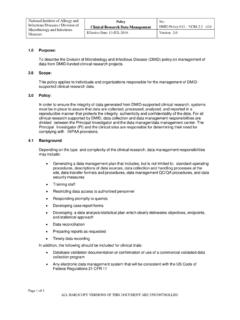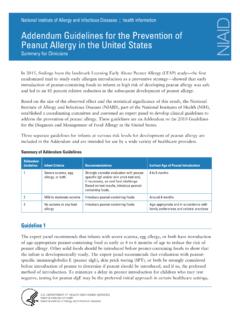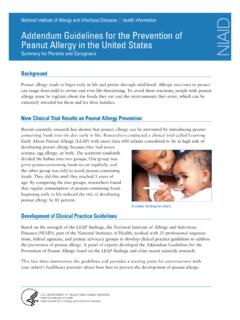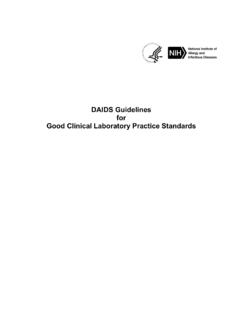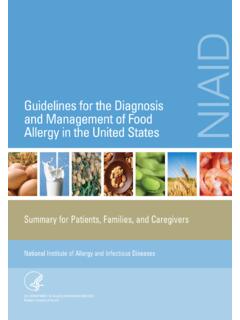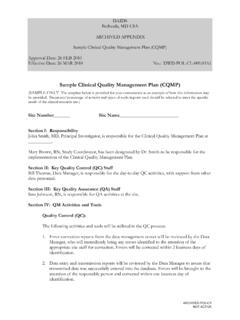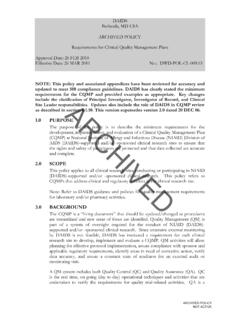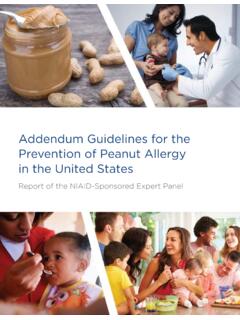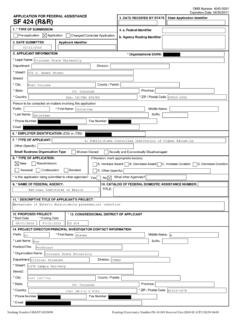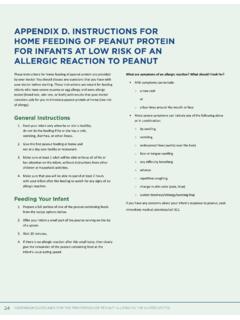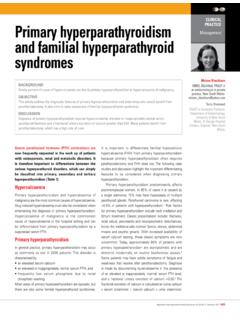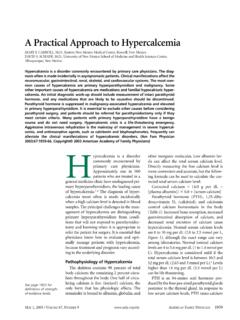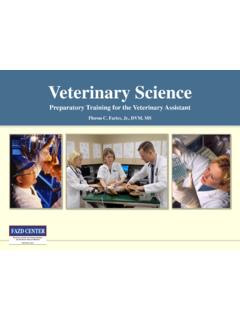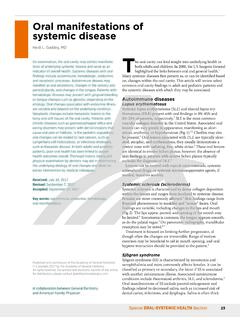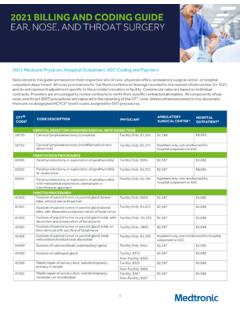Transcription of APECED - National Institute of Allergy and Infectious …
1 National Institute of Allergy and Infectious Diseases | health information NIAIDWhat Is APECED ? APECED is a rare genetic disorder characterized by problems with the immune system that affect many of the body s organs. APECED stands for autoimmune polyendocrinopathy candidiasis ecto-dermal dystrophy. People with APECED typically have chronic Candida yeast infections and various autoimmune problems. Breaking down the name, APECED , helps explain the refers to a process during which a person s immune system mistakenly attacks healthy cells, organs, or tissues. People with APECED often experience autoimmune problems with organs of the endocrine system, which secrete hormones into the blood to help regulate body functions. They also have autoimmunity against non-endocrine organs, including the liver, lungs, and intestines. For example, people with APECED may experience autoimmune hepatitis (the body mistakenly attacks the liver), autoimmune pneumonitis (the body mistakenly attacks the lungs), and autoimmune enteropathy (the body mistakenly attacks the intestines), as well as other autoimmune refers to problems with multiple endocrine glands.
2 In people with APECED , endocrinopathy is caused by autoimmunity. For example, autoimmune problems in the parathyroid and adrenal glands of APECED patients commonly cause hypocalcemia (low calcium levels), hypo-glycemia (low blood sugar), and hypotension (low blood pressure). Other autoimmune-mediated endocrine problems include ovarian or testicular failure, type 1 diabetes, thyroid disease, and pituitary failure (see the Glossary).Candidiasis is an infection caused by the yeast Candida. Candida infections of the skin and mucosal surfaces such as the mouth, esophagus, and vagina are common in people with APECED . However, people with APECED generally are not susceptible to developing systemic Candida infections, which involve the blood and deep-seated refers to the ectoderm, the most exterior of the three primary layers in an early embryo. The ectoderm gives rise to many important tissues and structures, including the skin, sweat glands, hair, nails, and is a state of weakness, degeneration, or abnormal development (in this case, of the ecto-derm).
3 People with APECED may have problems with their nails, hair, and the enamel on their teeth. For example, they may experience nail dystrophy, alopecia, or enamel hypoplasia (see the Glossary) with or without evidence of an accompanying Candida DEPARTMENT OF HEALTH AND HUMAN SERVICESN ational Institutes of HealthNational Institute of Allergy and Infectious DiseasesAPECED2 NIAIDD iagnosis of APECED , which also is called autoimmune polyendocrinopathy syndrome type 1 (APS-1) or polyglandular autoimmune (PGA) syndrome type 1, is based on clinical symptoms, laboratory findings, and genetic testing. Most people with APECED begin having symptoms in early childhood, although the time between onset of symptoms and APECED diagnosis can be frustratingly long for many families. The APECED research cohort at NIH is among the world s largest and most syndrome is caused by mutations in the gene AIRE.
4 AIRE provides instructions for making a protein called the autoimmune regulator (AIRE), which helps control when other genes get turned on, or expressed. The AIRE protein is expressed in the thymus, a key immune organ located behind the breastbone. As its name suggests, AIRE plays an important role in regulating certain aspects of the immune system. In particular, AIRE helps teach immune cells how to distinguish the body s own healthy cells and in the AIRE gene reduce or eliminate the function of the AIRE protein, making it more likely that the immune system will attack the body s own healthy tissues. This auto-immunity underlies many APECED of many types and in many locations along the length of the AIRE gene have been reported. Interestingly, different mutations have been found to be somewhat specific to certain populations. For example, the nonsense mutation R257X is common among Finnish APECED patients; the deletion mutation 1094-1106del13 is common among British, Irish, Norwegian, and North American APECED patients; and the missense mutation Y85C frequently appears among Iranian Jews with APECED (see the Glossary for more information about mutation types).
5 However, potential correlations between a specific AIRE mutation and a patient s clinical status remain is inherited in an autosomal recessive manner. In autosomal recessive inheritance, an affected person has a mutation on each of their two copies of the AIRE gene one inherited from the mother and one from the father. Typically, both parents of an affected person carry one abnormal AIRE gene and are unaffected by the disease. When both parents are carriers, each child has a 25 percent, or one in four, chance of being affected by the the two copies of the AIRE gene that a child inherits have identical, or homozygous, mutations. Most North American APECED patients have different mutations on the two copies of Genetics primer: Our bodies are made up of trillions of cells, which contain specialized proteins. The instructions for how, where, and when to make each protein are encoded by DNA, which is packaged into chromosomes.
6 A gene is a working subunit of DNA, like a chapter in a huge instruction manual. Mutations are errors in a gene, like a typo in a chapter. Credit: NIAID3 NIAIDNIAIDAIRE, called compound heterozygous mutations. In either case, the patient is not able to produce functional AIRE evidence suggests that in a minority of APECED patients, the disease is inherited in an autosomal dominant manner. In autosomal dominant inheritance, an affected person has a mutation on one of their two copies of the AIRE gene. The mutation is inherited from a parent who is also affected by the syndrome. The other parent does not carry a mutation in the AIRE gene and is healthy. In this situation, each child has a 50 percent, or one in two, chance of being affected by the disease. Such muta-tions have been reported in European APECED patients, but so far have not been observed in North American APECED 15 to 20 percent of North American patients with APECED symptoms do not have detectable mutations in both copies of the AIRE gene, suggesting that other undiscovered genetic factors also are involved in the syn-drome.
7 Understanding the genetic factors that contribute to APECED in families without AIRE gene mutations is an area of active research at may diagnose APECED based on genetic testing and the presence of at least two of the three classic components of the syndrome: chronic mucocutaneous candidiasis, hypoparathyroidism, and adrenal insufficiency (see the Glossary). However, these criteria are imperfect. Some patients have other symptoms for decades before the classic APECED symptoms become apparent or their doctor performs a targeted evaluation for APECED . The rarity of APECED and the variation in disease symptoms and severity among people with the disease contribute to the likely underdiagnosis of this condition. As researchers work toward a better characterization of APECED , the diagnostic criteria likely will FindingsAPECED is a disorder with striking variability, even within the same family.
8 This implies that complex interactions among genetic, epigenetic (influences on gene expression not explained by the DNA sequence), and environmental factors contribute to the Mucocutaneous CandidiasisChronic mucocutaneous candidiasis persistent Candida infection of the skin, nails, or mucosal membranes is typically the first symptom to appear, usually in the form of oral candidiasis, In this example, two unaffected parents each carry one copy of a gene mutation for an autosomal recessive disorder. They have one affected child and three unaffected children, two of which carry one copy of the gene mutation. Credit: National Library of Medicine4 NIAID commonly known as oral thrush. Thrush can range in severity from redness and soreness at the corners of the mouth to whole-mouth involvement, which can interfere with eating spicy or acidic foods. Chronic inflammation of the mouth and throat makes some APECED patients (5 to 10 percent) suscep-tible to oral squamous cell carcinoma, a type of cancer.
9 Candidiasis can also affect the esophagus, intestines, or can affect virtually any tissue or organ. Doctors have identified autoantibodies immune system proteins that recognize and counteract numerous tissues and organs in the body in people with APECED . In addition, autoreactive T cells, which normally are removed in the thymus in the presence of functional AIRE, attack different organs in people with APECED . Most commonly, autoantibodies and autoreactive T cells attack the parathyroid glands, adrenal glands, thyroid gland , and ovaries or testes. This can result in hypoparathyroidism, adrenal insufficiency, hypothyroid-ism, and ovarian or testicular failure (see the Glossary). Autoimmunity affecting the gastrointestinal tract, ecto-dermal structures (skin, teeth, nails, and parts of the eyes), spleen, blood, lungs, and other organs and tissues has also been reported in APECED SymptomsAPECED can affect structures of the ectoderm, resulting in a wide variety of symptoms.
10 These include keratitis of the eye, rashes with fever, alopecia, vitiligo, nail dystrophy, tooth enamel hypo-plasia, and calcification of the inner ear s tympanic membrane (see the Glossary). Some, but not all, of these symptoms may be caused by underlying autoimmune problems. NIH researchers are working to better understand the constellation of symptoms that people with APECED experience and the immune and nonimmune mechanisms that contribute to the is based on a person s clinical condition and may include medications and other strategies to manage Candida, autoimmunity, and endocrine problems. Some treatments may be specific for APECED , while others are standard treatments for conditions experienced by APECED patients, such as hypoparathyroidism. Because APECED affects many of the body s organs and tissues, optimal care requires a team of specialists working closely with the patient.
